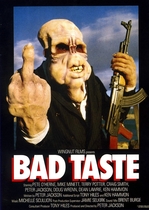Our editor-in-chief Nate Yapp is proud to have contributed to the new book Hidden Horror: A Celebration of 101 Underrated and Overlooked Fright Flicks, edited by Aaron Christensen. Another contributors include Anthony Timpone, B.J. Colangelo, Dave Alexander, Classic-Horror.com's own Robert C. Ring and John W. Bowen. Pick up a copy today from Amazon.com!
Hey You! Get Outta My Soul!
With the September 9th release of Lakeshore Entertainment's The Exorcism of Emily Rose coming up, I thought it'd be a good time to take a look at the history of exorcism in the modern horror film. My research revealed something that I really should have figured out sooner -- with few exceptions, every single exorcism film made after 1973 is either a rip-off or blatant cash-in on The Exorcist.
No country put out more of these rip-offs than Italy. The following is just a brief listing of the Italian exorcism films that came in the wake of The Exorcist. This is by no means definitive, and I encourage any oversights to be e-mailed to me through our contact form.
The Original:
The Exorcist (William Friedkin, 1973) -- No study of The Exorcist's progeny can be complete without a quick look at the original film itself. Although considered one of the great horror films, it still suffers from some inherent flaws dramatically. As a moral totem, it was unyielding. The Devil is bad. Questioning your faith is bad. The only person represented as truly heroic is Father Merrin, who is a stoic, knowledgable figure with absolute faith in his duties (something that would be retroactively muddled in Renny Harlin's prequel). The morally repulsive and the morally strong are the only effective combatants in the arena, while the values of the middle ground are represented as flaccid. Still, it is a shocking film, especially in its middle section before it gives itself over to true excess.
The Italian Imitators:
The House of Exorcism (aka Lisa and the Devil) (Mario Bava, 1973) -- Perhaps one of the most tragic stories to come out of the Exorcist cash-in craze. Bava, perhaps Italy's greatest horror director, originally produced a strange, meandering tale of fate and illusion titled Lisa and the Devil, which premiered at Cannes a full seven months before The Exorcist was released. Audience response was lackluster. Later, producer Alfredo Leone shot new footage featuring lead actress Elke Sommer and Robert Alda (who didn't feature in the original film) as an exorcist. The re-edited film was released in 1975 under the title The House of Exorcism, as is generally regarded as a piece of crap. Although Bava's original vision has its detractors -- it is a very, very strange, nonsensical film -- it is still the preferred.
The Antichrist (Alberto De Martino, 1974) -- Low-budget rip-off amped by an Ennio Morricone score. This time it's an evil ancestor instead of the devil, but it's the same pea soup and levitation game at the end of the day. Notable for its cinematographer: schlock maven Joe D'Amato.
Beyond the Door (Ovidio G. Assonitis & Robert Barrett, 1974) -- Possibly the most notorious of the imitations, Beyond the Door (or Chi Sei?) stirred a little Rosemary's Baby into the mix for flavor. Even more conservative in its morality than Friedkin's film, BtD portrays the sexually active as either evil or swell vessels for evil. More green vomit, head spinning, and wacky telekinesis, plus atrocious dubbing means that you may as well not bother. Mario Bava's Shock (1977) was retitled Beyond the Door II, but is unconnected.Return of the Exorcist (Franco Lo Cascio & Angelo Pannacciò, 1975) -- The Italian title translates to A Howl in the Darkness, but what they slapped on the US prints is much more telling. A nun's brother is possessed by the ghost of naked lady. Yawn.
The Exorcist: Italian Style (Ciccio Ingrassia, 1975) -- At least this one's honest about its intentions. Everybody gets possessed here, even the exorcist. Ostensibly a spoof of Friedkin's film, it was considered the Gigli of 1970s Italian cinema (according to the Internet Movie Database, anyway).
There are many more offenders from countries other than Italy, but that is a topic best broached in a separate article.







